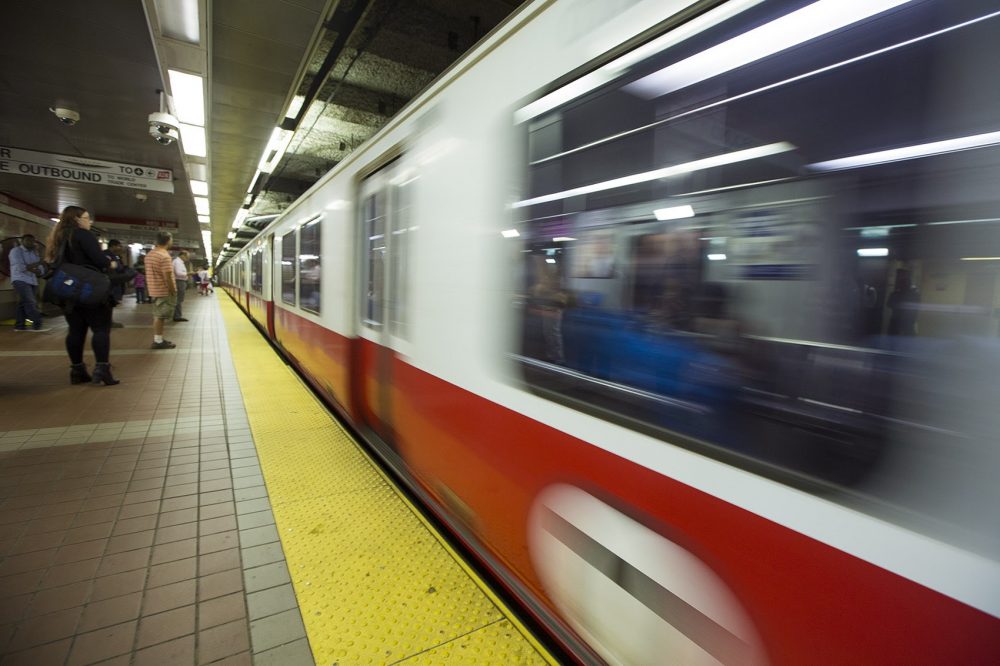Advertisement
Commentary
All On This Track Together: Riding The Vivid Underground

The JFK/UMass station bell announced the inbound train. I moved with the crowd, like crayons in a factory clip from "Mr. Rogers’ Neighborhood." I was on my way to hear my hero, Stacy Schiff, lecture at Boston's Central Public Library, access that my younger self could only dream of.
I glanced around the train car. The variety of people, the inherent democracy of the journey, was beautiful; I was acutely grateful for that ride and countless others. The T has carried me, along with millions who depended on the MBTA, from impoverished isolation to a wealth of vibrant experience.
Driving a car was once my catharsis. Years ago, when my children were babies, they often napped in the back seat of our car while I drove nowhere. A quarter of a tank of gas and the freeway could take me through roughly 200 miles of the Intermountain West while they slept. But for all that distance, the outlook, like the landscape, was still the color of wet potter’s clay. The road always curved back toward our beetle infested, subsidized apartment, in cultural and political homogeneity. My möbius strip of poverty was thousands of miles from any post-recession opportunities.
The T has carried me, along with millions who depended on the MBTA, from impoverished isolation to a wealth of vibrant experiences.
When luck took us to Boston, I fell in love with all the rough and shining facets of the city. Each detail, each building and person, added color and texture to my senses. The price of my new treasure was the car. In a matter of weeks, the cost of ownership became burdensome to the point of offensive. But, for the first time in my life, a car felt entirely unnecessary. We sold it and didn’t look back.
I pushed my babies around our new home in a stacked canvas carriage. They fell asleep as the subway car rocked along the track,the sound of the tunnel rushing by, a white noise lullaby. Babas and abuelas greeted me on the platform to coo at my boy and girl (what a blessing, they said).
In time, I shooed my little ones onto the train, where they knelt backward in the seats to see the underside of the world fly by. When Michelangelo’s sketches visited the Museum of Fine Arts, I got my hands on a picture book about the artist’s life. We read it together on the ride to the museum, one of many cherished adventures. Time on the train was time to be present, to be with my children instead of the traffic.
On the T, my children looked, with innocent fascination, at the kaleidoscope of humans. There sat a young woman with mint curls and a gray pantsuit. There was a man who was so tall, even without the bright red turban. A boy my son's age wore an outfit that matched his father's; perhaps they had a photo shoot.
Every citizen, regardless of description, has somewhere to be. The firmest common ground is the need for safe, dependable, affordable travel. Owning, maintaining and parking a car is a privilege. Participation in life should not require a giant machine that costs more than most Bostonians make in a year. And besides that, car crashes kill more teens in the United States than anything else, with 30 percent more occurrences in rural areas than urban, thanks to public transportation.
Elegant solutions to infrastructure and funding would prove that elected officials, as well as voters, value equal rights. To paraphrase Enrique Peñalosa, urban activist and mayor of Bogatá, Colombia, an advanced city is where even the richest citizens opt to use the public transit.
If a paradigm shift toward supporting the T will strengthen our community, the act of riding the T strengthens us at an individual level.
If a paradigm shift toward supporting the T will strengthen our community, the act of riding the T strengthens us at an individual level. In "Triumph of the City," Edward Glaeser cited studies that revealed, “face-to-face contact leads to more trust, generosity, and cooperation than any other sort of interaction.” A daily ride on the MBTA has subtle power, person by person, to improve our empathy and problem solving in matters racial, religious or gender-concerned. That’s a power that self-driving technology could never wield.
The MBTA transports Bostonians from what’s past to what’s ahead, 400 million times a year. Inside each trolley is a microcosm as diverse as the city above it. Supporting its maintenance and growth, in turn, supports equal rights and prioritizes the community. We come from different places, we leave with different intentions, but we’re all on this track together.
